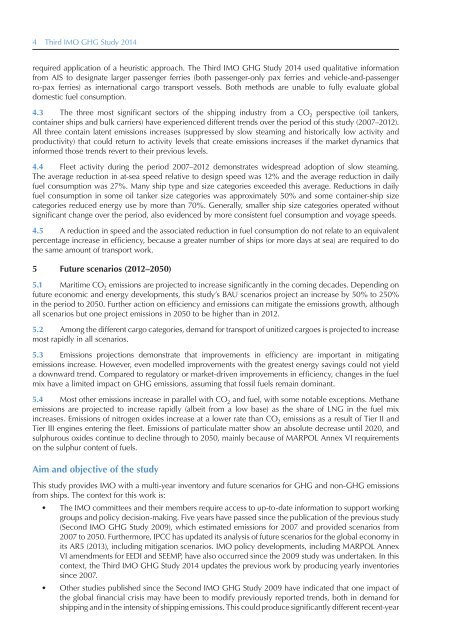Third IMO Greenhouse Gas Study 2014
GHG3%20Executive%20Summary%20and%20Report
GHG3%20Executive%20Summary%20and%20Report
You also want an ePaper? Increase the reach of your titles
YUMPU automatically turns print PDFs into web optimized ePapers that Google loves.
4 <strong>Third</strong> <strong>IMO</strong> GHG <strong>Study</strong> <strong>2014</strong><br />
required application of a heuristic approach. The <strong>Third</strong> <strong>IMO</strong> GHG <strong>Study</strong> <strong>2014</strong> used qualitative information<br />
from AIS to designate larger passenger ferries (both passenger-only pax ferries and vehicle-and-passenger<br />
ro-pax ferries) as international cargo transport vessels. Both methods are unable to fully evaluate global<br />
domestic fuel consumption.<br />
4.3 The three most significant sectors of the shipping industry from a CO 2 perspective (oil tankers,<br />
container ships and bulk carriers) have experienced different trends over the period of this study (2007–2012).<br />
All three contain latent emissions increases (suppressed by slow steaming and historically low activity and<br />
productivity) that could return to activity levels that create emissions increases if the market dynamics that<br />
informed those trends revert to their previous levels.<br />
4.4 Fleet activity during the period 2007–2012 demonstrates widespread adoption of slow steaming.<br />
The average reduction in at-sea speed relative to design speed was 12% and the average reduction in daily<br />
fuel consumption was 27%. Many ship type and size categories exceeded this average. Reductions in daily<br />
fuel consumption in some oil tanker size categories was approximately 50% and some container-ship size<br />
categories reduced energy use by more than 70%. Generally, smaller ship size categories operated without<br />
significant change over the period, also evidenced by more consistent fuel consumption and voyage speeds.<br />
4.5 A reduction in speed and the associated reduction in fuel consumption do not relate to an equivalent<br />
percentage increase in efficiency, because a greater number of ships (or more days at sea) are required to do<br />
the same amount of transport work.<br />
5 Future scenarios (2012–2050)<br />
5.1 Maritime CO 2 emissions are projected to increase significantly in the coming decades. Depending on<br />
future economic and energy developments, this study’s BAU scenarios project an increase by 50% to 250%<br />
in the period to 2050. Further action on efficiency and emissions can mitigate the emissions growth, although<br />
all scenarios but one project emissions in 2050 to be higher than in 2012.<br />
5.2 Among the different cargo categories, demand for transport of unitized cargoes is projected to increase<br />
most rapidly in all scenarios.<br />
5.3 Emissions projections demonstrate that improvements in efficiency are important in mitigating<br />
emissions increase. However, even modelled improvements with the greatest energy savings could not yield<br />
a downward trend. Compared to regulatory or market-driven improvements in efficiency, changes in the fuel<br />
mix have a limited impact on GHG emissions, assuming that fossil fuels remain dominant.<br />
5.4 Most other emissions increase in parallel with CO 2 and fuel, with some notable exceptions. Methane<br />
emissions are projected to increase rapidly (albeit from a low base) as the share of LNG in the fuel mix<br />
increases. Emissions of nitrogen oxides increase at a lower rate than CO 2 emissions as a result of Tier II and<br />
Tier III engines entering the fleet. Emissions of particulate matter show an absolute decrease until 2020, and<br />
sulphurous oxides continue to decline through to 2050, mainly because of MARPOL Annex VI requirements<br />
on the sulphur content of fuels.<br />
Aim and objective of the study<br />
This study provides <strong>IMO</strong> with a multi-year inventory and future scenarios for GHG and non-GHG emissions<br />
from ships. The context for this work is:<br />
• The <strong>IMO</strong> committees and their members require access to up-to-date information to support working<br />
groups and policy decision-making. Five years have passed since the publication of the previous study<br />
(Second <strong>IMO</strong> GHG <strong>Study</strong> 2009), which estimated emissions for 2007 and provided scenarios from<br />
2007 to 2050. Furthermore, IPCC has updated its analysis of future scenarios for the global economy in<br />
its AR5 (2013), including mitigation scenarios. <strong>IMO</strong> policy developments, including MARPOL Annex<br />
VI amendments for EEDI and SEEMP, have also occurred since the 2009 study was undertaken. In this<br />
context, the <strong>Third</strong> <strong>IMO</strong> GHG <strong>Study</strong> <strong>2014</strong> updates the previous work by producing yearly inventories<br />
since 2007.<br />
• Other studies published since the Second <strong>IMO</strong> GHG <strong>Study</strong> 2009 have indicated that one impact of<br />
the global financial crisis may have been to modify previously reported trends, both in demand for<br />
shipping and in the intensity of shipping emissions. This could produce significantly different recent-year


